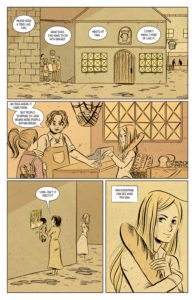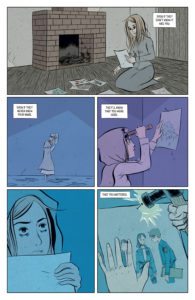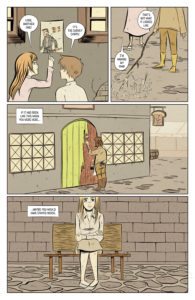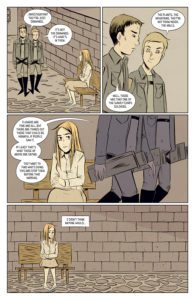 Attack On Titan, FCBD 2017
Attack On Titan, FCBD 2017
Jody Houser (w), Emi Lennox (a), Paolo Rivera (cover)
Kodansha
May 6, 2017
Last year, Kodansha published a giant anthology of original Attack On Titan stories by Western creators. The series’ creator, Hajime Isayama, was as enthusiastic about the project as he is about his weird manga becoming such a huge international hit — Isayama just wants everyone to love gross giants as much as he does. Seeing fans embrace his weird vision has been great, but having creators take his world out for a test drive is its own reward. The Attack On Titan anthology demonstrated that it’s not just the gross giants we’ve come to love — god do we AOT fans love them — but the wider world Isayama has created and is still building, both within and without the walls, and particularly the hints of how that world, where people are hunkered down inside walls a hundred meters high in fear of very hungry giants came to be. But where many of the stories in last year’s anthology explored hitherto unseen aspect of Isayama’s world — in the distant past or some distant locale — Kodansha’s new FCDB story from Jody Houser and Emi Lennox instead looks within the walls to tell a story narrow in scope but broad in sentiment and implication.
Before ice cold Erwin Smith became the 13th Commander of the Survey Corps, before even the erstwhile Commander turned drill instructor Keith Shaddis’ time, a different Commander — a blonde woman who goes unnamed in this issue — took her troops out on an expedition and returned with some success. Or, success as the Survey Corps measures it — they mostly didn’t die, save for those who did.
That success for Attack On Titan‘s core group of soldiers, the ones who ride out beyond the walls to battle those hungry titans, is generally measured in not being slaughtered is a source of continual pathos for Attack On Titan proper. But, save for some few incidents where the Survey Corps soldiers are confronted with angry townspeople, and when Captain Levi visits with the families of his deceased squad members, it’s not something that’s fully explored — that impact. The series’ focus on the lives of young soldiers is necessary; it’s what propels the plot as the heroes navigate the various conspiracies and disasters that surround and befall them. I’ve always wondered though what it’s like for the people who wait inside the walls to see if this time their parent, child, sibling, lover, or friend would return whole, in pieces, or not at all.
Houser and Lennox explore that experience, the waiting and the terrible knowing, through Ava, sister to a young Survey Corps soldier who never makes it back. In a scene familiar to any reader or viewer of AOT, she rushes out to meet the returning troops, only to find that her brother Liam came home on his horse, but he didn’t come home alive; just a body to bury. Ava, though, has more than this to remember him by because Liam kept a sketchbook, secreted away under the floorboards of their home, with pictures of his fellow Survey Corps members and his travels beyond the walls. In AOT the seldom seen King and the too often seen Wall Cult have forbidden knowledge of the world from before and almost all information about the world outside of the walls. Liam’s sketchbook then is dangerously seditious material. He drew it and Ava reads at risk of arrest and worse. This is the other main attraction of AOT, that in addition to those cheerfully gross giants roaming outside the walls hungry for human flesh, within the walls the people face overwhelming oppression by religious and secular authorities. Knowledge is closely guarded, speech carefully monitored, and food and other essential supplies are almost always rationed, the nobles meanwhile dancing and drinking and politicking while ordinary folks suffer starvation, persecution, and death by giants. Houser and Lennox are a great choice for this story, which explains the impact of this situation on one ordinary girl. They have a softer, more measured touch than Isayama (and less interest in screamy teens).
Ava is very unlike Eren Jaeger, ostensible hero of Isayama’s Attack On Titan, whose fierce anger over the injustices of their world pushes him to join the Survey Corps and vow to destroy all titans. She is not quite like Isayama’s Armin or even his Christa, who are less hard-edged than their friend and compatriot Eren, more liable to think through problems and more capable of real empathy. Ava is not a character who could fit in the manga’s main storyline– not a doomed but determined Survey Corps soldier, scheming politician, or mad scientist. But she is a great addition to the wider AOT world, a character who practices a form of non-violent resistance within the walls, through art and ideology, but who demonstrates the same fierce resolve that we have come to expect from Isayama’s favourites. Ava wants to remember her brother better, you see, and to share the images of beauty and wonder that he passed on to her — so she shares those images with the people within the walls, pasting them up all over Wall Maria. This goes as you might expect it to, with both moments of revelation for the common folk and terror for those above. That is all I will say about the plot of this comic — you will have to read the issue, which is available for free in stories participating in FCBD on May 6, to learn the rest.
As mentioned, Lennox is a great fit for this story, her compositions clean but expressive, narrow and drab inside the world within the walls but opening and brightening up as Ava does too. She and Houser are both restrained, where Isayama seems unfamiliar with the concept — the whole story is a muted, evenly paced, contrast to the always-intense hijinks of AOT. It’s not that serious things aren’t happening here, but that this, Ava’s story, matches its heroine, who possesses a quiet power. So much is said with just Ava’s posture, expression, and scant words. Like the stories in last year’s AOT anthology, this one provides a necessarily different take on Isyama’s weird world, and one that may serve as a good entry point for new readers. It is, certainly, a less bloody introduction than the manga or anime, which begin with a titan attack, but it is no gentler in the end, for all that Houser and Lennox take a softer approach.





